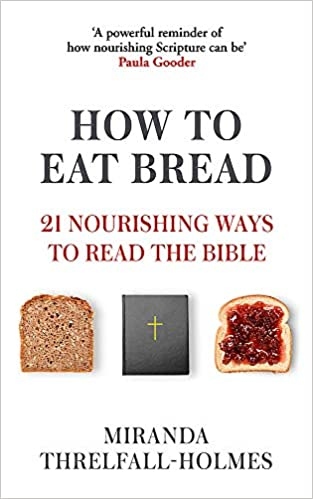How to Eat Bread by Miranda Threlfall-Holmes
Short, accessible yet thorough guide to 21 diverse and meaningful methods of reading the Bible
 How to Eat Bread
How to Eat Bread
By Miranda Threlfall-Holmes
Hodder & Stoughton
ISBN: 9781529364477
Reviewer: Amanda Higgin
How do I read the Bible? It seems like a simple enough question but, as most of us will have discovered at one time or other, “pick it up and start reading” isn’t a good enough answer. This 2000 year-old library of texts is so important to our faith, yet so often creates a stumbling block for Christians whether young or old, new or experienced. In How to Eat Bread, Miranda Threlfall-Holmes will not tell you how to read the Bible, but offers 21 diverse and meaningful methods by which it can enrich our faith.
Some readers may be sceptical about the book’s premise. After all, isn’t the best way to read the Bible simply to read it? If that’s you, the first chapter of How to Eat Bread should be encouraging: a selection of ways to read the Bible drawn from the Bible itself. In this chapter, ‘From the Larder’, Threlfall-Holmes draws insights from the way characters in the Bible tell stories and how the New Testament cites the Old.
In her second chapter, ‘Grandma’s Recipe Book’, she draws on Christian tradition to explain ways of reading like lectio divina, allegory, and Augustine’s rule of love. Finally, she describes the fresh insights of modern theological studies in ‘Molecular Gastronomy’, offering tools not only to access academic commentaries but also to experiment in the ways we read the Bible together.
Threlfall-Holmes’s book is short and accessible. Some of her chapters are only six pages long, but in those pages she presents a thorough guide to a single approach to reading the Bible, using language anyone could understand. Despite this, she is unafraid of the difficult bits of the Bible that can be stumbling block, and invites the reader to face them head-on using the methods she describes.
The appendix contains instructions for reading the book as a group, and even if you read How to Eat Bread alone it would be worth taking time to chew over each chapter as you read it. Each section provides suggested scriptural texts to practice applying its method, so that the proof of the pudding can indeed be in the eating.
Some chapters may feel frustratingly simple to experienced Christians, but I nevertheless believe the book is worth reading. It invites the reader to reflect on those familiar methods, to ask whether they are still the best way to read the Bible, and to experiment with something new. I began the chapter on ecological reading feeling sceptical, but was thoroughly persuaded by Threlfall-Holmes’s artful exegesis of the familiar parable of the sower: she challenges our focus on the human sower, so that by asking new questions about the birds, the seed, and the soil of the land, we can appreciate new answers.
The message of How to Eat Bread is not to find a “right way” to read the Bible, but to learn how to experiment, how to question our assumptions, and how to experience the Bible as so much more than a book.
Amanda Higgin is a ministerial student at Regent’s Park college, reading for a Masters’ degree in New Testament theology
Baptist Times, 17/09/2021